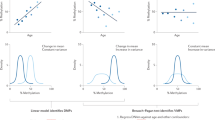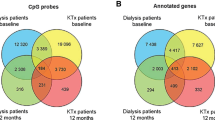Abstract
Epigenomics regulates gene expression and is as important as genomics in precision personal health, as it is heavily influenced by environment and lifestyle. We profiled whole-genome DNA methylation and the corresponding transcriptome of peripheral blood mononuclear cells collected from a human volunteer over a period of 36 months, generating 28 methylome and 57 transcriptome datasets. We found that DNA methylomic changes are associated with infrequent glucose level alteration, whereas the transcriptome underwent dynamic changes during events such as viral infections. Most DNA meta-methylome changes occurred 80–90 days before clinically detectable glucose elevation. Analysis of the deep personal methylome dataset revealed an unprecedented number of allelic differentially methylated regions that remain stable longitudinally and are preferentially associated with allele-specific gene regulation. Our results revealed that changes in different types of ‘omics’ data associate with different physiological aspects of this individual: DNA methylation with chronic conditions and transcriptome with acute events.
This is a preview of subscription content, access via your institution
Access options
Access Nature and 54 other Nature Portfolio journals
Get Nature+, our best-value online-access subscription
$29.99 / 30 days
cancel any time
Subscribe to this journal
Receive 12 print issues and online access
$209.00 per year
only $17.42 per issue
Buy this article
- Purchase on Springer Link
- Instant access to full article PDF
Prices may be subject to local taxes which are calculated during checkout






Similar content being viewed by others
References
Ball, M. P. et al. Harvard Personal Genome Project: lessons from participatory public research. Genome Med. 6, 10 (2014).
Chen, R. et al. Personal omics profiling reveals dynamic molecular and medical phenotypes. Cell 148, 1293–1307 (2012).
Hood, L. & Friend, S. H. Predictive, personalized, preventive, participatory (P4) cancer medicine. Nat. Rev. Clin. Oncol. 8, 184–187 (2011).
Li-Pook-Than, J. & Snyder, M. iPOP goes the world: integrated personalized omics profiling and the road toward improved health care. Chem. Biol. 20, 660–666 (2013).
Snyder, M., Du, J. & Gerstein, M. Personal genome sequencing: current approaches and challenges. Genes Dev. 24, 423–431 (2010).
Mias, G. I. & Snyder, M. Personal genomes, quantitative dynamic omics and personalized medicine. Quant. Biol. 1, 71–90 (2013).
Horvath, S. DNA methylation age of human tissues and cell types. Genome Biol. 14, R115 (2013).
Kanzleiter, T. et al. Exercise training alters DNA methylation patterns in genes related to muscle growth and differentiation in mice. Am. J. Physiol. Endocrinol. Metab. 308, E912–E920 (2015).
Rowlands, D. S. et al. Multi-omic integrated networks connect DNA methylation and miRNA with skeletal muscle plasticity to chronic exercise in Type 2 diabetic obesity. Physiol. Genomics 46, 747–765 (2014).
Gertz, J. et al. Analysis of DNA methylation in a three-generation family reveals widespread genetic influence on epigenetic regulation. PLoS Genet. 7, e1002228 (2011).
Ideraabdullah, F. Y., Vigneau, S. & Bartolomei, M. S. Genomic imprinting mechanisms in mammals. Mutat. Res. 647, 77–85 (2008).
Li, Y. & Sasaki, H. Genomic imprinting in mammals: its life cycle, molecular mechanisms and reprogramming. Cell Res. 21, 466–473 (2011).
Bergman, Y. & Cedar, H. DNA methylation dynamics in health and disease. Nat. Struct. Mol. Biol. 20, 274–281 (2013).
Kundaje, A. et al. Integrative analysis of 111 reference human epigenomes. Nature 518, 317–330 (2015).
Lister, R. et al. Human DNA methylomes at base resolution show widespread epigenomic differences. Nature 462, 315–322 (2009).
Lister, R. et al. Highly integrated single-base resolution maps of the epigenome in Arabidopsis . Cell 133, 523–536 (2008).
Panda, K. et al. Full-length autonomous transposable elements are preferentially targeted by expression-dependent forms of RNA-directed DNA methylation. Genome Biol. 17, 170 (2016).
Hansen, K. D., Langmead, B. & Irizarry, R. A. BSmooth: from whole genome bisulfite sequencing reads to differentially methylated regions. Genome Biol. 13, R83 (2012).
Harrow, J. et al. GENCODE: the reference human genome annotation for The ENCODE Project. Genome Res. 22, 1760–1774 (2012).
Newman, A. M., Liu, C. L. & Green, M. R. Robust enumeration of cell subsets from tissue expression profiles. Nat. Methods 12, 453–457 (2015).
Kellis, M. et al. Defining functional DNA elements in the human genome. Proc. Natl Acad. Sci. USA 111, 6131–6138 (2014).
Ernst, J. & Kellis, M. ChromHMM: automating chromatin-state discovery and characterization. Nat. Methods 9, 215–216 (2012).
Wahl, S. et al. Epigenome-wide association study of body mass index, and the adverse outcomes of adiposity. Nature 541, 81–86 (2017).
Kuleshov, V. et al. Whole-genome haplotyping using long reads and statistical methods. Nat. Biotechnol. 32, 261–266 (2014).
Xi, Y. & Li, W. BSMAP: whole genome bisulfite sequence MAPping program. BMC Bioinformatics 10, 232 (2009).
Li, H. et al. The Sequence Alignment/Map format and SAMtools. Bioinformatics 25, 2078–2079 (2009).
Dobin, A. et al. STAR: ultrafast universal RNA-seq aligner. Bioinformatics 29, 15–21 (2013).
Trapnell, C. et al. Differential gene and transcript expression analysis of RNA-seq experiments with TopHat and Cufflinks. Nat. Protoc. 7, 562–578 (2012).
Kundaje, A. et al. Integrative analysis of 111 reference human epigenomes. Nature 518, 317–330 (2015).
McLean, C. Y. et al. GREAT improves functional interpretation of cis-regulatory regions. Nat. Biotechnol. 28, 495–501 (2010).
Acknowledgements
This work is supported by the following grants from the National Institutes of Health: 5U54DK10255603 and 5P50HG00773503 (M.S.); by grants 91631111, 31571327 and 31771426 from Chinese National Natural Science Foundation (D.X.); as well as by funding from Stanford University. M.S. is a cofounder and member of the scientific advisory board of Personalis and Q-bio.
Author information
Authors and Affiliations
Contributions
M.S., D.X. and R.C. conceived and designed the study. R.C. performed the experiments and generated the data with the help of K.K. and J.L.-P.-T. R.C., L.X., K.T. and M.D. analyzed the data. M.S., D.X., R.C., L.X. and K.T. wrote the paper. All authors read, edited and approved the final manuscript.
Corresponding authors
Ethics declarations
Competing interests
The authors declare no competing interests.
Additional information
Publisher’s note: Springer Nature remains neutral with regard to jurisdictional claims in published maps and institutional affiliations.
Supplementary information
Supplementary Text and Figures
Supplementary Figures 1–9
Supplementary Table 1
Health parameters of the participant
Supplementary Table 2
The DMR between adjacent time points using Bsmooth algorithm
Supplementary Table 3
The DMR between glucose level elevated state and normal state using Bsmooth algorithm
Supplementary Table 4
List of results from functional enrichment analysis of ADV1-specific DEGs and ADV2-specific DEGs
Supplementary Table 5
List of all aDMRs and their associated genes
Supplementary Table 6
RNA-seq read counts of each sample
Rights and permissions
About this article
Cite this article
Chen, R., Xia, L., Tu, K. et al. Longitudinal personal DNA methylome dynamics in a human with a chronic condition. Nat Med 24, 1930–1939 (2018). https://doi.org/10.1038/s41591-018-0237-x
Received:
Accepted:
Published:
Issue Date:
DOI: https://doi.org/10.1038/s41591-018-0237-x
This article is cited by
-
Gene expressions between obligate bamboo-eating pandas and non-herbivorous mammals reveal converged specialized bamboo diet adaptation
BMC Genomics (2023)
-
Integrative genomic analyses in adipocytes implicate DNA methylation in human obesity and diabetes
Nature Communications (2023)
-
Longitudinal analysis of individual cfDNA methylome patterns in metastatic prostate cancer
Clinical Epigenetics (2021)
-
DNA methylation signature on phosphatidylethanol, not on self-reported alcohol consumption, predicts hazardous alcohol consumption in two distinct populations
Molecular Psychiatry (2021)
-
The potential of using blood circular RNA as liquid biopsy biomarker for human diseases
Protein & Cell (2021)



